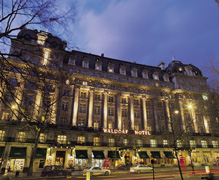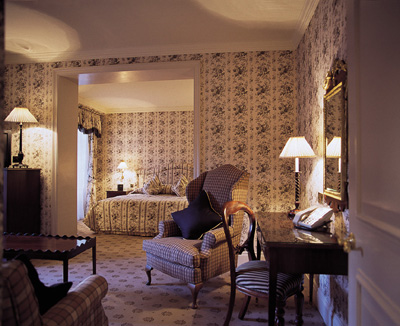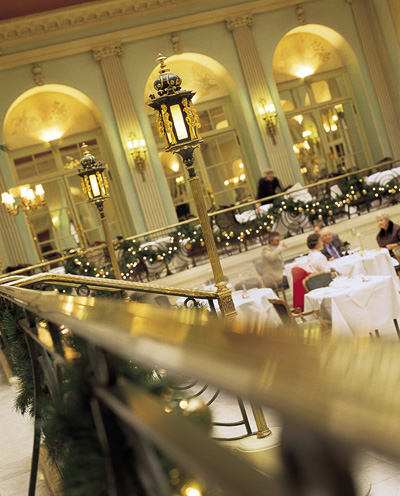|
HOTEL LE MERIDIEN
WALDORF*****
Aldwych
London WC2B 4DD
United Kingdom

In 1889 the London County
Council plans to widen the famous street the Strand and set about the biggest
land clearance since the Great Fire of 1666. Eight acres of buildings and
streets were to go, making way for a grand new crescent called the Aldwych.
Parliamentary wrangling over the cost meant work did not start until 1900, at
the end of the reign of Queen Victoria and the beginning of that of Edward V11.
Edward Saunders, Manager of the Coronet Theatre in Notting Hill Gate followed
these plans with interest, having great ambitions to have his own theatre. He
enlisted the support of theatregoer Thomas Wild a Chartered Accountant, and
although it was later claimed to be his idea to add a hotel, it was in fact Wild
who proposed the project.
The name Saunders and Wild chose for their company seemed to imply there was
Astor money involved and rumours to this effect still persist. In fact the name
seems simply to be one they picked because it had a ring of cache about it, for
at that time William Waldorf Astor, who had just become a naturalised British
subject, was the richest man in the world. Astor ironically later went down with
the Titanic, the ship who’s ballroom was inspired by the Palm Court at the
Waldorf.
If the name was synonymous with success, it did not work out that
way for the partners. Alexander Marshall Mackenzie of Aberdeen was signed as
Architect and set about his design for a hotel and theatre. Shares in the
syndicate did not sell well and two other theatres opened adjacent to the site,
further depressing the scheme. By 1905 the foundations had been laid but little
finance remained available to continue. That year the new King officially opened
the Aldwych, albeit with it’s centrepiece well and truly under construction.
It was the Architect Mackenzie who rescued the project, bringing in another
Scot, John Macdonald Henderson. The Waldorf syndicate was wound up and the
Waldorf Hotel Company established with a share capital of £350,000. Saunders and
Wild were both paid off with shares in the new company.
Mackenzie had seen the latest hotel in the United States and was
eager to adopt the higher ratio of bathrooms to bedrooms than was common in the
UK. He also forecast that being in the heart of theatreland, the hotel would
become ‘one of the greatest centres of London amusement’. He made good his
predictions and from the 190 foot frontage of Aberdeen granite soared sculptured
Portland stone in columns of French Renaissance style with statues representing
the arts and sciences. The finished hotel was a majestic example of Edwardian
building and earnt Mackenzie enormous respect and the contract to design
Australia House at the end of the Aldwych. The interior rivalled the exterior
thanks largely to Waring & Gillow, who not only carried out the decoration but
supplied everything to run it – even the music sheets and instruments for the
house orchestra.
The official opening was on Tuesday 28th January 1908. An excited
public saw innovations such as an electric light by each bed, telephones in
every room and the hotel’s own telephone exchange, prompting one newspaper to
write “ Residents will thus be able at any time of day or night to obtain or
exchange communication with any part of London or the provinces”.
The public rooms included a billiards room, a ladies drawing room
with the very latest in musical boxes and a large pile of metal discs to while
away the time whilst the gentlemen drank in their bar called the Smoking Room.
It was here the stage door Johnnies from the nearby legal chambers used to
gather before going to collect the ‘Gaeity Girls’ from the new Gaeity Theatre
opposite. There was no doubt the hotel would be a success. One newspaper called
it a ‘new Palace for the people’ and the daily Graphic observed that “a bachelor
will be able to have the run of the place for a guinea and a half a week”.
It’s location and celebrity brought a quick succession of famous
names , amongst them Lily Langtry, Ivor Novello, George Bernard Shaw and
Gertrude Lawrence.
The outbreak of the first world war brought a darker time to the hotel and
included the bombing of the Aldwych theatre. In it’s aftermath times became
lighter and music once again enlivened the hotel. The Tango was first introduced
here and the 1920’s saw the introduction of the Waldorf’s trademark tango teas
which continue today. The Palm Court orchestra was run by a Mr Mantovani, father
of the now famous namesake. The Waldorfians made hundreds of records and their
name was in lights outside the hotel until war again came in 1939.
The ensuing years saw the hotel struggle to regain it’s past glory and it took
the intervention of Charles Forte in 1958 to see matters turn once again. Forte
had made his name as a caterer and passionately wanted to enter the hotel
business. Having raised the necessary £600k his dream began, swiftly building an
empire of some 800 hotels worldwide.
In 1992 the hotel was closed for 9 months and a major refurbishment took place,
including the redecoration of every bedroom and the installation of air
conditioning. In 1995 the Waldorf became Le Meridien Waldorf, still within the
Forte organization, and was awarded 5 star status.
Today many stars and celebrities still visit – even the Spice Girls chose it to
celebrate the opening of their movie !
All 292
bedrooms and suites are decorated to a high standard, capturing the theatrical
Edwardian origins but complementing them with modern equipment and facilities
required by today’s traveller.
- Individually controlled air conditioning
- Bath & shower
- Private Bar
- International Satellite Television
- Pay Movies
- Sony Play station
- Direct Dial Telephone with modem connection &
Voicemail
- Safety Deposit Box
- UK, European & US power
- Trouser Press
- 24 Hour Room Service

|
Breakfast is
served in the magnificent Palm Court.
Monday - Friday
7.00am - 10.00am
Saturday - Sunday
7.30am - 10.30am
Aldwych Brasserie
- Bistro style restaurant serving lunch afternoon tea and evening meals.
Monday - Sunday
11.00am - 10.30pm |
 |

Prices available upon request.
![[Dividing Line Image]](images/div.gif)
Back to Home Page
![[Dividing Line Image]](images/div.gif)
Our Address :

Fil
Franck Tours, 176 Lexington Avenue, New York, NY 10016 - Tel : (212) 685 56 56
- Fax (212) 481 24 94 -
Toll free in the
USA (800) 669 8165
- ©1998-1999 Fil Franck Tours
-
 Electronic mail Electronic mail
General Information:
infos@Filfranck.com
|



